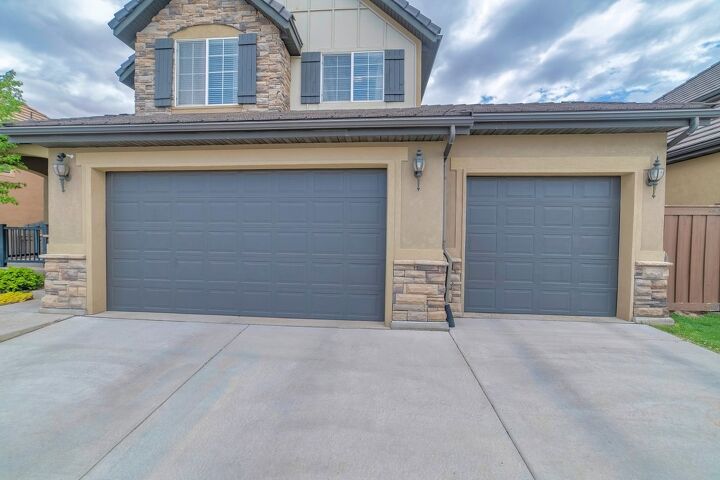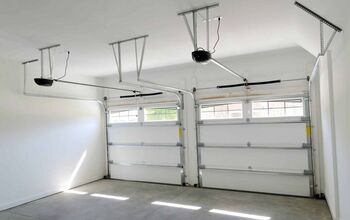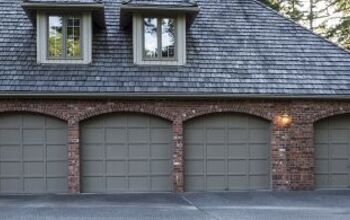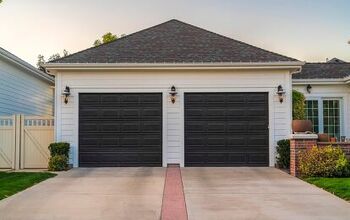3 Car Garage Dimensions (with Drawings)

You rely on your vehicle every day, so naturally, you want to keep it safe. Many people prefer to keep their cars under lock and key in a garage. Plus, most households have multiple vehicles, so it’s worth considering 3 car garage dimensions.
The minimum size for a 3 car garage is 20 to 22 feet deep and 30 to 32 feet wide, which fits three small cars. If you have an SUV or truck, 25 feet deep by 36 feet minimum would be a better fit and allow for storage or work space. Other common sizes for a 3 car garage are 38 by 26 feet and 40 by 30 feet.
There aren’t set measurements for a three-car garage, and you can go as big as your available space allows. However, there is definitely an unofficial minimum since you have to fit vehicles comfortably and safely. You also want to consider what else you plan to do in your garage to determine the best size for you.
Minimum 3 Car Garage Dimensions
If you build a 3 car garage, plan for it to be a minimum of 20 feet wide and 30 feet deep. These dimensions are the smallest you can really go and still feet three small cars.
Not only can you fit the three vehicles, but you can maneuver in and out of them. The general rule is to keep a minimum of 30 inches between cars to open the door and enter or exit the vehicle.
You should also have this amount of space on the outside of the end cars between the vehicle and the wall. You can do this with three small cars, but it won’t be the roomiest option.
If you have limited space for your garage, this small size might be your only option. Others might opt for this size if they only plan to park two cars but also want to store smaller vehicles. For example, maybe you also want to keep a golf cart or ride-on lawnmower in your garage.
Or if you only have two vehicles but want to incorporate storage and a small workspace into your garage. Then, this 20 to 22-feet x 30 to 32-feet footprint could work well for you.
Ideal 3 Car Garage Dimensions
If you want a three-car garage to fit your vehicles, it’s best to go bigger if you can. The only reason to stick with the minimum size is if you don’t have adequate space to go larger.
However, if you have the space and the wiggle-room in your budget, a larger 3-car garage is more practical. Even bumping it up to 25 feet deep and 36 feet wide gives you room to fit an SUV or truck along with two small cars.
Additionally, you could park three cars comfortably and have room to spare for things like bikes, lawn equipment, and storage. You could also fit a small workbench or work area. But, you likely can’t store your extra gear and have a work area in this space.
The size you choose depends on your needs, budget, space, and your intended use for your garage. If you want it all, opt for an even more oversized garage. Other common 3 car garage dimensions are 38 by 26 feet and 40 by 30 feet.
What Size 3 Car Garage Is Best For You?
To determine the best size 3 car garage for you, think about your vehicles first. After all, if the garage isn’t large enough to house your vehicles, then it becomes a bit pointless.
Different vehicles have different sizes but don’t just base your garage size on your current cars or trucks. You undoubtedly will get a different vehicle or two at some point in your life, so allow yourself some flexibility.
For example, a compact car is typically 6 feet wide and 15 feet long. A smart car is less than 9 feet long and about 6’2 inches wide. However, larger luxury sedans measure closer to 7 feet wide and 16 to 17 feet long.
However, if you have SUVs and trucks, you’ll need even more room for these oversized vehicles. For example, an SUV can be roughly 17 feet long and 6 to 7 feet wide.
A pickup truck is typically about 7 to 8 feet wide. But it’s the length you need to watch. Most pickups are 19 to 20 feet long, making a minimum three-car garage that is only 20 feet deep a no-go.
Examples Of How Minimum 3 Car Garage Dimensions Work With Different Vehicles
A three-car garage that works for one person could be a nightmare for others. Consider this example.
You have three small compact cars in a minimum 20 feet deep by 30 feet wide garage. Overall, the vehicles take up 18 feet of the garage’s width.
You leave the recommended 30 inches of space between each vehicle and the side walls. This clearance space accounts for another 10 feet of your garage’s width.
You would have just enough space to fit these three small cars and maneuver around them comfortably. However, you have no real space left for anything else like storage or workspace.
Another Example
But you’re in better shape than your best friend, who has the same size garage but owns two SUVs and one sedan. Your friend’s vehicles take up about 20 feet of his garage’s width, along with another 10 feet of clearance space. He’s maxed out at 30 feet, making this garage a cramped and crowded space.
However, if either of you trades in a vehicle for a pickup truck, you’re out of luck. The 20-foot extended pick-up won’t even fit in your 20-feet deep garage. If housing two trucks, you need to go for a minimum of 24 by 24 feet for your garage.
If you plan to add storage space or a work zone, then you should get a 3-car garage for two trucks. You should go wider to 28 or 30 feet at the least. Or, you can go deeper to about 28 or 32 feet and put the storage and work area on the back wall.
Do You Need A Bigger Garage?
If you think it will be a tight squeeze, take some time to carefully consider what else you will do in your garage. Do you plan to work there? Store sports equipment, extra holiday decorations, etc.?
You need to add space for anything you plan to use your garage for, not just your vehicles. Adding some more space to your garage can make a huge difference. Consider your friend from the above example.
What if he decided to build a garage that was 28 feet deep and 36 feet wide? He would end up with is also an excellent example of how6 extra feet of width and have a roomy 8 to 10 feet of depth to play with along the back wall.
An average workbench is typically 2 to 3 feet deep and between 6 and 8 feet long. Storage cabinets can range from 12 inches deep to 18 inches deep.
Therefore, carefully plan out how you intend to use the space in your garage. Map it out on paper and make sure you can fit everything you want along with adequate clearance space.
Finally, don’t forget that building a bigger garage will carry increased costs, such as wiring and garage lighting.
Tips For Adding Storage To A Smaller Garage
If you don’t have the available space for an oversized garage, you need to get creative with the space you do have. When trying to maximize storage space in a tiny garage, go vertical. The average garage has a minimum 8’0 ceiling height.
You can add racks on the ceiling to hold storage bins, bikes, and things like kayaks and other equipment. You can even suspend a lawnmower from the ceiling with the right supplies.
Consider making it taller with an attic or loft space when initially building your garage. This is especially good if you only have room for a single-car garage. Maximizing your vertical space can effectively double or even triple your storage.
What About A Connected 2-Car And Single-Car Garage?
What if you don’t have the available land area for a conventional three-car garage? You could take a cue from this floorplan, with a two-car garage and connected one-car garage.
This option works well if your lot has more depth than width. It also is an excellent example to show that you have options when designing your ultimate garage.
Deciding On Your Garage Door
With a three-car garage, you also need to decide on your garage door setup. You can either do a single garage door and a double door or three separate doors.
The double and single combo works well in offset garages or connected double and single garages like above. However, if your garage is an enlarged space, consider getting three separate garage doors. This choice provides a more symmetrical and pleasing look to your home’s exterior.
In Conclusion
At a minimum, a 3 car garage needs to be 20 to 22 feet deep and 30 to 32 feet wide to fit three small cars. However, it should be at least 25 feet deep by 36 feet wide if you have larger vehicles and want to include storage or a work area. Other common 3-car garage sizes are 38 by 26 feet and 40 by 30 feet.
Decide how you want your garage to function and what you want to keep in it. Then, along with your available space, you can decide on the best three-car garage size for you.

Stacy Randall is a wife, mother, and freelance writer from NOLA that has always had a love for DIY projects, home organization, and making spaces beautiful. Together with her husband, she has been spending the last several years lovingly renovating her grandparent's former home, making it their own and learning a lot about life along the way.
More by Stacy Randall






























![How To Reset A Whirlpool Cabrio Washer [In 5 Easy Steps!]](https://cdn-fastly.upgradedhome.com/media/2023/07/31/9076531/how-to-reset-a-whirlpool-cabrio-washer-in-5-easy-steps.jpg?size=350x220)



